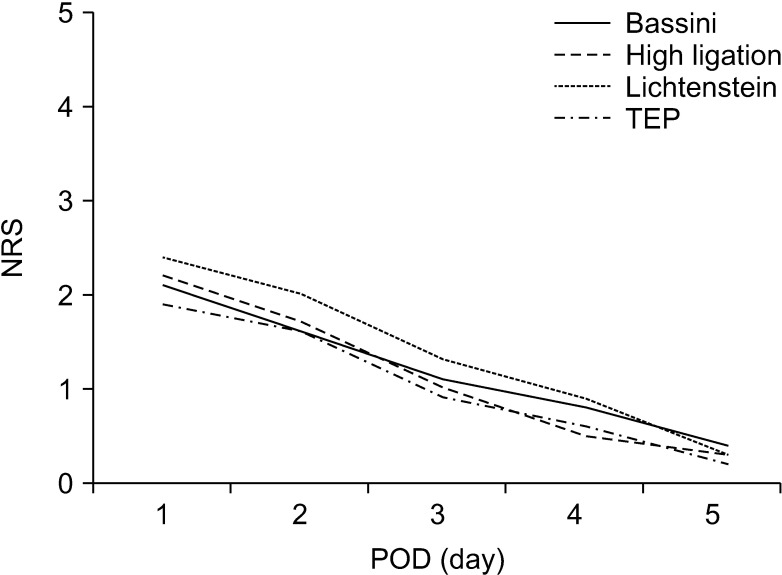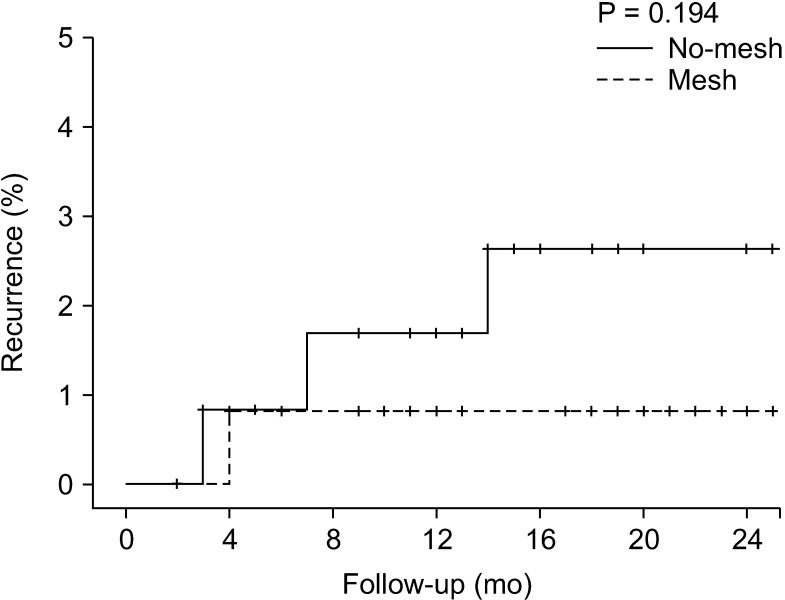Ann Surg Treat Res.
2021 Apr;100(4):246-251. 10.4174/astr.2021.100.4.246.
Inguinal hernia repair with or without mesh in late adolescent males
- Affiliations
-
- 1Department of Surgery, Armed Forces Capital Hospital, Seongnam, Korea
- 2Department of Hepatobiliary and Pancreatic Surgery, Severance Hospital, Yonsei University College of Medicine, Seoul, Korea
- 3Department of Surgery, Korea Institute of Radiological & Medical Sciences, Seoul, Korea
- KMID: 2514722
- DOI: http://doi.org/10.4174/astr.2021.100.4.246
Abstract
- Purpose
Inguinal hernia repair is one of the most common treatments worldwide, but there are few studies about the use of mesh in late adolescent patients because hernias are rare in this group. This study aimed to evaluate the postoperative outcomes of hernia repair with and without mesh in late adolescent patients.
Methods
We retrospectively reviewed the data of 243 male patients aged between 18 and 21 years who underwent inguinal hernia repair at a single institution from January 2013 to December 2017. We distinguished 2 groups depending on the repair method; mesh (n = 121) and no-mesh (n = 122) groups. We compared the baseline characteristics, immediate postoperative outcomes, and recurrence and chronic pain rates between the 2 groups.
Results
There were no significant differences between the mesh and no-mesh groups on immediate postoperative outcomes (length of stay: 18.5 ± 8.9 days vs. 17.0 ± 6.0 days, P = 0.139; postoperative complications: 8.2% vs. 6.6%, P = 0.821) and 2-year recurrence rate (0.8% vs. 2.6%, P = 0.194). There was a significant difference in the chronic pain rate (9.0% vs. 1.7%, P = 0.023).
Conclusion
Using mesh for inguinal hernia repair in late adolescent male patients increases chronic postoperative inguinal pain.
Keyword
Figure
Reference
-
1. Kingsnorth A, LeBlanc K. Hernias: inguinal and incisional. L ancet. 2003; 362:1561–1571.
Article2. Burcharth J, Pedersen M, Bisgaard T, Pedersen C, Rosenberg J. Nationwide prevalence of groin hernia repair. PLoS One. 2013; 8:e54367. PMID: 23342139.
Article4. Ruhl CE, Everhart JE. Risk factors for inguinal hernia among adults in the US population. Am J Epidemiol. 2007; 165:1154–1161. PMID: 17374852.
Article5. HerniaSurge Group. Internat ional guidelines for groin hernia management. Hernia. 2018; 22:1–165.6. Othersen HB Jr. The pediatric inguinal hernia. Surg Clin North Am. 1993; 73:853–859. PMID: 8378824.
Article7. Rosenberg J. Pediatric inguinal hernia repair: a critical appraisal. Hernia. 2008; 12:113–115. PMID: 18060351.8. Simons MP, Aufenacker T, Bay-Nielsen M, Bouillot JL, Campanelli G, Conze J, et al. European Hernia Society guidelines on the treatment of inguinal hernia in adult patients. Hernia. 2009; 13:343–403. PMID: 19636493.
Article9. Bay-Nielsen M, Nilsson E, Nordin P, Kehlet H. Swedish Hernia Data Base the Danish Hernia Data Base. Chronic pain after open mesh and sutured repair of indirect inguinal hernia in young males. Br J Surg. 2004; 91:1372–1376. PMID: 15376186.10. Bisgaard T, Bay-Nielsen M, Kehlet H. Groin hernia repair in young males: mesh or sutured repair? Hernia. 2010; 14:467–469. PMID: 20454990.
Article11. Criss CN, Gish N, Gish J, Carr B, McLeod JS, Church JT, et al. Outcomes of adolescent and young adults receiving high ligation and mesh repairs: a 16-year experience. J Laparoendosc Adv Surg Tech A. 2018; 28:223–228. PMID: 29261090.
Article12. Bruns NE, Glenn IC, McNinch NL, Rosen MJ, Ponsky TA. Treatment of routine adolescent inguinal hernia vastly differs between pediatric surgeons and general surgeons. Surg Endosc. 2017; 31:912–916. PMID: 27357926.
Article13. Downie WW, Leatham PA, Rhind VM, Wright V, Branco JA, Anderson JA. Studies with pain rating scales. Ann Rheum Dis. 1978; 37:378–381. PMID: 686873.
Article14. Meissner W, Mescha S, Rothaug J, Zwacka S, Goettermann A, Ulrich K, et al. Quality improvement in postoperative pain management: results from the QUIPS project. Dtsch Arztebl Int. 2008; 105:865–870. PMID: 19561807.15. Aasvang E, Kehlet H. Chroni c postoperative pain: the case of inguinal herniorrhaphy. Br J Anaesth. 2005; 95:69–76. PMID: 15531621.16. Charalambous MP, Charalambous CP. Incidence of chronic groin pain following open mesh inguinal hernia repair, and effect of elective division of the ilioinguinal nerve: meta-analysis of randomized controlled trials. Hernia. 2018; 22:401–409. PMID: 29550948.
Article17. Jung JS, Sohn M. Korea's military service policy issues and directions for mid- & long-term development. Korean J Def Anal. 2011; 23:473–488.18. Rusk HA, Taylor EJ. Army air forces convalescent training program. Ann Am Acad Polit Soc Sci. 1945; 239:53–59.
Article19. Wittenbecher F, Scheller-Kreinsen D, Röttger J, Busse R. Comparison of hospital costs and length of stay associated with open-mesh, totally extraperitoneal inguinal hernia repair, and transabdominal preperitoneal inguinal hernia repair: an analysis of observational data using propensity score matching. Surg Endosc. 2013; 27:1326–1333. PMID: 23093240.
Article20. Ljungqvist O, Scott M, Fearon KC. Enhanced recovery after surgery: a review. JAMA Surg. 2017; 152:292–298. PMID: 28097305.21. Rawal N. Current issues in postoperative pain management. Eur J Anaesthesiol. 2016; 33:160–171. PMID: 26509324.
Article22. EU Hernia Trialists Collaboration. Mesh compared with non-mesh methods of open groin hernia repair: systematic review of randomized controlled trials. Br J Surg. 2000; 87:854–859. PMID: 10931018.23. Kehlet H, Bay-Nielsen M. Danish Hernia Database Collaboration. Nationwide quality improvement of groin hernia repair from the Danish Hernia Database of 87,840 patients from 1998 to 2005. Hernia. 2008; 12:1–7. PMID: 17939015.
Article24. van Kerckhoven G, Toonen L, Draaisma WA, de Vries LS, Verheijen PM. Herniotomy in young adults as an alternative to mesh repair: a retrospective cohort study. Hernia. 2016; 20:675–679. PMID: 27522362.
Article25. Bjurstrom MF, Nicol AL, Amid PK, Chen DC. Pain control following inguinal herniorrhaphy: current perspectives. J Pain Res. 2014; 7:277–290. PMID: 24920934.26. Bignell M, Partridge G, Mahon D, Rhodes M. Prospective randomized trial of laparoscopic (transabdominal preperitoneal-TAPP) versus open (mesh) repair for bilateral and recurrent inguinal hernia: incidence of chronic groin pain and impact on quality of life: results of 10 year follow-up. Hernia. 2012; 16:635–640. PMID: 22767210.
Article27. Hu QL, Chen DC. Approach to the patient with chronic groin pain. Surg Clin North Am. 2018; 98:651–665. PMID: 29754628.
Article28. Sawyer SM, Azzopardi PS, Wickremarathne D, Patton GC. The age of adolescence. Lancet Child Adolesc Health. 2018; 2:223–228. PMID: 30169257.
Article
- Full Text Links
- Actions
-
Cited
- CITED
-
- Close
- Share
- Similar articles
-
- A Comparision of the Mesh Technique in Inguinal Hernia Repair with the Non-mesh Method
- To Minimize Post-operative Pain in Inguinal Hernia Repair: Single-port Laparoscopic Totally Extraperitoneal Inguinal Hernia Repair without Fixation of the Mesh
- Outcome of the patients with chronic mesh infection following open inguinal hernia repair
- Management of Infected Mesh after Laparoscopic Incisional Hernia Repair
- Mesh Plug Hernia Repair



